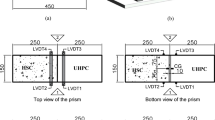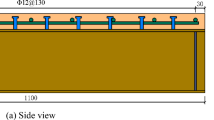Abstract
Accurate quantification of early-age tensile creep is vital to determine the stress build-up and the related crack sensitivity of concrete structures. Performing tensile creep testing in concrete is a challenging task and therefore reliable test data reported in literature is rather limited. The available test data indicates a large scatter and there is no consensus in the scientific community regarding early-age basic creep in tension. Besides, most of the prediction models in design codes are mainly calibrated using long-term compressive creep test data and their capabilities for predicting early-age tensile creep remain questionable. This paper first presents a comprehensive set of test data on early-age tensile creep of high-performance concrete using two unique methods, namely a Temperature Stress Testing Machine and a direct tensile test setup. The reliability of the collected data is demonstrated through the good agreement between the test data generated by these two test setups. Autogenous shrinkage measurements are performed simultaneously and used for determining basic tensile creep profiles. The governing factors affecting tensile creep including loading age, strength and temperature are experimentally explored in depth. The limitations of the widely utilized basic creep prediction model in the fib Model Code 2010 are identified. Based on the newly measured test data, modifications to the existing model are proposed. The proposed model better reflects not only the data collected in this study, but also that in other published data, thereby highlighting the capabilities of this model for accurate assessment of early-age basic tensile creep of high-performance concrete.








Similar content being viewed by others
References
Pane I, Hansen W (2002) Early age creep and stress relaxation of concrete containing blended cements. Mater Struct 35(2):92. https://doi.org/10.1007/BF02482107
Maruyama I, Lura P (2019) Properties of early-age concrete relevant to cracking in massive concrete. Cem Concr Res 123:105770. https://doi.org/10.1016/j.cemconres.2019.05.015
Delsaute B, Torrenti JM, Staquet S (2017) Modeling basic creep of concrete since setting time. Cement Concr Compos 83:239–250. https://doi.org/10.1016/j.cemconcomp.2017.07.023
Forth JP (2015) Predicting the tensile creep of concrete. Cement Concr Compos 55:70–80
Bamforth PB (2007) Early-age thermal crack control in concrete (CIRIA C660). CIRIA, London, UK
Gilbert RI (2017) Cracking caused by early-age deformation of concrete – prediction and control. Procedia Engineering 172:13–22
Hilaire A, Benboudjema F, Darquennes A, Berthaud Y, Nahas G (2014) Modeling basic creep in concrete at early-age under compressive and tensile loading. Nucl Eng Des 269:222–230. https://doi.org/10.1016/j.nucengdes.2013.08.034
ACI Committee 209, ACI 209R-92 Prediction of creep, shrinkage, and temperature effects in concrete structures (2009). American Concrete Institute
fib (2013) fib Model Code for Concrete Structures (2010) Wiley-VCH Verlag GmbH & Co. KGaA, Weinheim, Germany. doi:https://doi.org/10.1002/9783433604090
Zdeněk P. Bažant MJ (2018) Creep and hygrothermal effect in concrete structures, vol 225. Solid Mechanics and Its Applications. Springer Nature, Netherland
Klausen AE, Kanstad T, Bjøntegaard Ø, Sellevold E (2017) Comparison of tensile and compressive creep of fly ash concretes in the hardening phase. Cem Concr Res 95:6
Wei Y, Hansen W (2013) Tensile creep behavior of concrete subject to constant restraint at very early ages. J Mater Civ Eng 25:1277–1284
Rossi P, Tailhan J-L, Le Maou F (2013) Comparison of concrete creep in tension and in compression: influence of concrete age at loading and drying conditions. Cem Concr Res 51:78–84. https://doi.org/10.1016/j.cemconres.2013.04.001
Ji GM, Kanstad T, Bjøntegaard Ø, Sellevold EJ (2013) Tensile and compressive creep deformations of hardening concrete containing mineral additives. Mater Struct 46(7):1167–1182. https://doi.org/10.1617/s11527-012-9962-7
Atrushi DS (2003) Tensile and compressive creep of early age concrete: Testing and modelling. PhD Thesis, The Norwegian University of Science and Technology, Norway
Briffaut M, Benboudjema F, Torrenti J-M, Nahas G (2012) Concrete early age basic creep: Experiments and test of rheological modelling approaches. Constr Build Mater 36:373–380. https://doi.org/10.1016/j.conbuildmat.2012.04.101
Li L, Dabarera AGP, Dao V (2020) Time-zero and deformational characteristics of high performance concrete with and without superabsorbent polymers at early ages. Constr Build Mater. https://doi.org/10.1016/j.conbuildmat.2020.120262
Kolver K, Igarashi S, Bentur A (1999) Tensile creep behavior of high strength concretes at early ages. Mater Struct 32(5):383–387. https://doi.org/10.1007/BF02479631
Bažant Z, Baweja S (2000) Creep and shrinkage prediction model for analysis and design of concrete structures: Model B3. ACI Special Publication Creep and Shrinkage of Concrete
Bažant ZP, Baweja S (1996) Short form of creep and shrinkage prediction model B3 for structures of medium sensitivity. Mater Struct 29(10):587–593
Byard BE, Schindler AK (2015) Modeling early-age stress development of restrained concrete. Mater Struct 48(1):435–450. https://doi.org/10.1617/s11527-013-0194-2
Benboudjema F, Torrenti JM (2008) Early-age behaviour of concrete nuclear containments. Nucl Eng Des 238(10):2495–2506. https://doi.org/10.1016/j.nucengdes.2008.04.009
Hermerschmidt W, Budelmann H Creep of early age concrete under variable stress. In: CONCREEP 2015: Mechanics and physics of creep, shrinkage, and durability of concrete and concrete structures - proceedings of the 10th international conference on mechanics and physics of creep, shrinkage, and durability of concrete and concrete structures, 2015. pp 929–937. doi:https://doi.org/10.1061/9780784479346.111
Japan Concrete Institute, Guidelines for control of cracking of mass concrete 2016 (2016). 2 edn., Tokyo
Schindler AK (2004) Effect of temperature on hydration of cementitious materials. ACI Mater J 101(1):72–81
Poole J, Riding K, Folliard K, Juenger M, Schindler AK (2007) Methods for calculating activation energy for Portland cement. ACI Mater J 104:303–311
Wang J, Yan P, Yu H (2007) Apparent activation energy of concrete in early age determined by adiabatic test. Journal of Wuhan University of Technology-Mater Sci Ed 22(3):537–541. https://doi.org/10.1007/s11595-006-3537-9
Xu Y, Liu J, Liu J, Zhang P, Zhang Q, Jiang L (2018) Experimental studies and modeling of creep of UHPC. Constr Build Mater 175:643–652. https://doi.org/10.1016/j.conbuildmat.2018.04.157
Le Roy R, Le Maou F, Torrenti JM (2017) Long term basic creep behavior of high performance concrete: data and modelling. Mater Struct 50(1):85
Torrenti JM, Le Roy R (2018) Analysis of some basic creep tests on concrete and their implications for modeling. Struct Concr 19(2):483–488
Müller HS, Anders I, Breiner R, Vogel M (2013) Concrete: treatment of types and properties in fib Model Code 2010. Struct Concr 14(4):320–334. https://doi.org/10.1002/suco.201200048
Garas VY, Kahn LF, Kurtis KE (2009) Short-term tensile creep and shrinkage of ultra-high performance concrete. Cement Concr Compos 31(3):147–152. https://doi.org/10.1016/j.cemconcomp.2009.01.002
Dao VTN, Dux PF, Morris PH (2009) Tensile properties of early-age concrete. ACI Materials Journal 106 (6). doi:https://doi.org/10.14359/51663330
Nguyen DH, Dao VTN, Lura P (2017) Tensile properties of concrete at very early ages. Constr Build Mater 134:563–573. https://doi.org/10.1016/j.conbuildmat.2016.12.169
Nguyen DH, Nguyen VT, Lura P, Dao VTN (2019) Temperature-stress testing machine – A state-of-the-art design and its unique applications in concrete research. Cement Concr Compos 102:28–38. https://doi.org/10.1016/j.cemconcomp.2019.04.019
Australian Standard, AS 1012.9: Methods of testing concrete- Method 9: Determination of the compressive strength of concrete specimens (1999). Standards Australia
Australian Standard, AS1012.17: Methods of testing concrete- Method 17: Methods for the determination of the static chord modulus of elasticity and Poisson’s ratio of concrete specimens (2014). Standards Australia
Li L, Dao V, Lura P (2021) Autogenous deformation and coefficient of thermal expansion of early-age concrete: Initial outcomes of a study using a newly-developed Temperature Stress Testing Machine. Cement Concr Compos 119:103997. https://doi.org/10.1016/j.cemconcomp.2021.103997
Australian Standard, AS 1012.2: Methods of testing concrete- Method 2: Preparing concrete mixes in the laboratory (2014). Standards Australia
Kovler K (1994) Testing system for determining the mechanical behaviour of early age concrete under restrained and free uniaxial shrinkage. Mater Struct 27(6):324–330. https://doi.org/10.1007/BF02473424
Khan I, Castel A, Gilbert RI (2017) Tensile creep and early-age concrete cracking due to restrained shrinkage. Constr Build Mater 149:705–715
Li L, O'Moore L, Dux P, Lura P, Dao V (2018) Evolution of coefficient of thermal expansion of concrete at early ages. Paper presented at the 25th Australasian Conference on Mechanics of Structures and Materials (ACMSM25), Brisbane, Australia
Li L, Dabarera AGP, Dao V (2020) Basic tensile creep of concrete with and without superabsorbent polymers at early ages (submitted). Construction and Building Materials
Lothenbach B, Winnefeld F, Alder C, Wieland E, Lunk P (2007) Effect of temperature on the pore solution, microstructure and hydration products of Portland cement pastes. Cem Concr Res 37(4):483–491. https://doi.org/10.1016/j.cemconres.2006.11.016
Wyrzykowski M, Scrivener K, Lura P (2019) Basic creep of cement paste at early age - the role of cement hydration. Cem Concr Res 116:191–201. https://doi.org/10.1016/j.cemconres.2018.11.013
Bažant ZP, Prasannan S (1989) Solidification theory for concrete. creep I: Formulation. Journal of engineering mechanics 115(8):1691–1703
Bažant ZP, Prasannan S (1989) Solidification theory for concrete. creep II: Verification and application. Journal of Engineering mechanics 115(8):1704–1725
Østergaard L, Lange DA, Altoubat SA, Stang H (2001) Tensile basic creep of early-age concrete under constant load. Cem Concr Res 31(12):1895–1899. https://doi.org/10.1016/S0008-8846(01)00691-3
Bissonnette B, Pigeon M (1995) Tensile creep at early ages of ordinary, silica fume and fiber reinforced concretes. Cem Concr Res 25(5):1075–1085. https://doi.org/10.1016/0008-8846(95)00102-I
Hauggaard AB, Damkilde L, Hansen PF (1999) Transitional thermal creep of early age concrete. J Eng Mech 125(4):458–465
Vidal T, Sellier A, Ladaoui W, Bourbon X (2015) Effect of temperature on the basic creep of high-performance concretes heated between 20 and 80°C. J Mater Civ Eng 27(7):B4014002
Acknowledgements
The authors acknowledge the financial support from the Australia Research Council project (DP 180103160). The first author appreciates the RTP scholarship granted by the Australian Government.
Funding
This study was funded by the Australia Research Council project (DP 180103160). The first author also appreciates the RTP scholarship granted by the Australian government to conduct this research work.
Author information
Authors and Affiliations
Contributions
AD: Conceptualization, Methodology, Investigation, Writing- original draft, Writing—review & editing. LL: Investigation, Writing—review & editing. VD: Conceptualization, Methodology, Supervision, Project administration, Funding acquisition, Writing—review & editing.
Corresponding authors
Ethics declarations
Conflict of interest
The authors declare that they have no known competing financial interests or personal relationships that could have appeared to influence the work reported in this paper.
Additional information
Publisher's Note
Springer Nature remains neutral with regard to jurisdictional claims in published maps and institutional affiliations.
Rights and permissions
About this article
Cite this article
Dabarera, A., Li, L. & Dao, V. Experimental evaluation and modelling of early-age basic tensile creep in high-performance concrete. Mater Struct 54, 130 (2021). https://doi.org/10.1617/s11527-021-01722-w
Received:
Accepted:
Published:
DOI: https://doi.org/10.1617/s11527-021-01722-w




